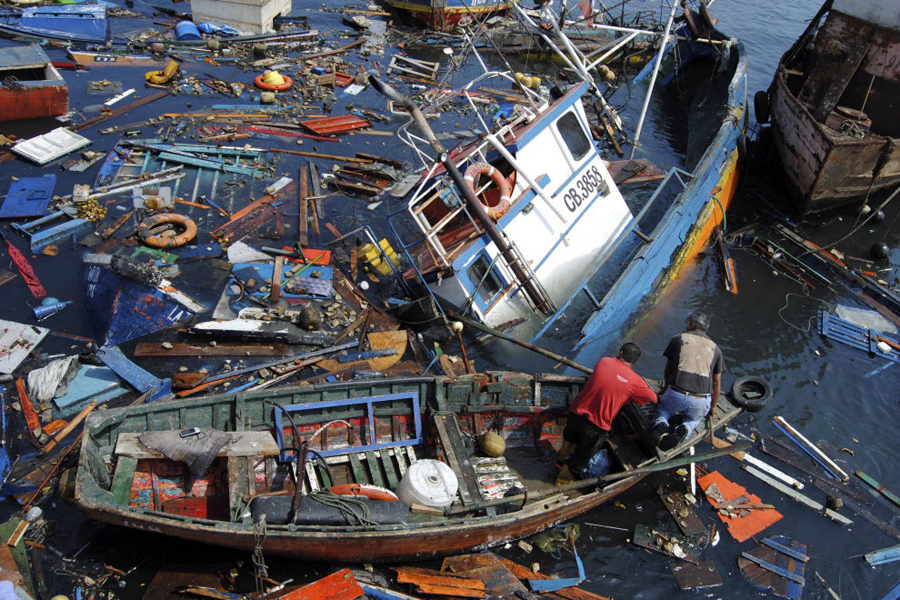Earthquake aftermath: Chile learns from 2010 quake missteps
| Santiago, Chile
The large earthquake that struck Chile Tuesday night didn't just trigger an emergency response and tsunami warning within minutes. It also called up memories of the failed 2010 response to another massive earthquake that triggered a devastating tsunami in southern Chile.
Since then, the southern cone country, which experiences frequent seismic activity, seems to have made important strides in improving how its government, non-profit organizations, and citizens respond. Yesterday's 8.2 magnitude earthquake, with an epicenter located some 59 miles offshore from the northern coastal city of Iquique, caused mostly localized damage. It was, in part, a sign of Chile's progress in natural-disaster preparedness, observers say.
“[Chile's response] showed that institutions function and that they can learn from their errors,” says Patricio Navia, a columnist and professor at New York University.
Last night's quake came just weeks after President Michelle Bachelet was sworn into office for her second, nonconsecutive term. The timing wasn't lost on Chileans: The 2010 temblor hit just days before President Bachelet closed out her 2006-10 term. At the time, her emergency preparedness office made the mistake of not sharing a tsunami alert given by another agency following the 8.8 magnitude temblor; most of the estimated 500 dead lost their lives to the resulting tsunami.
But minutes after Tuesday's earthquake, a tsunami alarm in Iquique was sounded, government officials said. And shortly afterwards a large scale evacuation order was issued for all of Chile's coastal areas, affecting over 900,000 people.
Over the course of the night in Iquique, waves topping six-feet-high crashed into the city causing minor flooding. A fleet of boats in a nearby fishing pier was severely damaged. Some roads were blocked by landslides, and electricity and water was cut in both Iquique and Arica, a city nearly 200 miles further to the north. So far six people have been confirmed dead.
Emergency officials provided half-hour updates with damage assessments, and activated an internal emergency response system among government officials from small-town mayors to ministers.
Addressing the news media, Bachelet said the emergency response system had worked. “First off, there was information, provided quickly and opportunely, in order to make the right decisions,” she told a mid-day news conference in the affected areas.
Past mistakes
The 2010 response was roundly criticized. And this week the former head of the office of emergency management was found guilty of involuntary manslaughter in connection to the government's failure to pass on the tsunami alert to those in the wave's path.
In addition to the errors in communicating the tsunami threat, observers say the system of how to respond to the ensuing disaster was non-existent then.
“In 2010, nobody knew who was in command,” says Mr. Navia. “And there was no control.”
In a country that suffered a military takeover in 1973, Bachelet, a member of the Socialist Party, was reluctant to call upon the military to control a large city to avoid looting, Navia said.
Since then, Chile has implemented a number of policies, from the placement of signs indicating tsunami escape routes in coastal cities, to greater coordination of emergency response among state agencies and with aid organizations, and rapid communication by authorities via smart phone alerts, to avert a repeat performance.
This week, Bachelet didn’t hesitate to sign an order allowing the military to take control over the emergency response in the worst affected areas.
“In general, the population is significantly better prepared,” too, says Paola Avello, the national head of emergency response and humanitarian aid for World Vision, a US-based aid group, pointing to the rapid evacuation of citizens in coastal areas. She also credits the local expertise in emergencies that has been developed in the last four years.
In the months leading up to last night's quake, for example, Iquique had participated in practice evacuation drills, Navia says.
But despite the relatively low number of fatalities after Tuesday's quake, Ms. Avello says that education on individual disaster preparedness needs more work.
“Once people evacuate they don’t know what to do,” Avello says. “There is still a lot to learn.”





